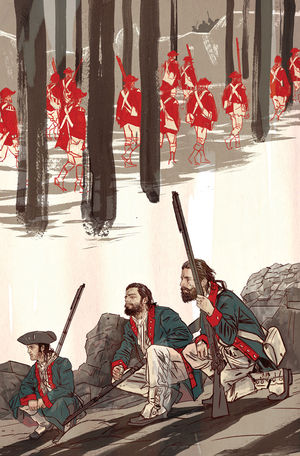by Alexander Lu
Art: Andrea Mutti
Colors: Jordie Bellaire
Letters: Jared K. Fletcher
New Hampshire’s state motto, “Live Free or Die,” has always captivated me. It’s raw and aggressive. It’s frenetic and energetic in a way that captures the revolutionary feel of a newborn nation struggling to find its footing. While Breaking Bad may recently brought the slogan back into the modern cultural discourse, Brian Wood’s (The Massive) and Andrea Mutti’s (Star Wars) historical narrative, Rebels, sets out to explore the history behind those four powerful words.
In its first issue, Wood and Mutti successfully lay the groundwork for a gripping historically-based narrative that explores the origin of The Green Mountain Boys, an American militia that captured Fort Ticonderoga during the American Revolutionary War. The story is told through the eyes of Seth Abbott, who is introduced to us in a beautifully scripted and drawn opening sequence where Seth, under the guidance of his generally distant father, finds the courage to open fire on a group of British soldiers attempting to take over farmers’ land in the Albany territory and thus blossoms into adulthood just as America begins to emerge an independent nation. The story then cuts to show us Seth as an adult, quelling a conflict between British militiamen and disgruntled American farmers at a Pennsylvania courthouse.
Rebels is not an unbiased comic. At one point, the team shows British soldiers opening fire on unarmed American protesters, clearly aiming to cast the Americans as martyrs and the redcoats as ruthless villains. As the lead protagonist and a native resident of the colonies, Seth is definitely portrayed as an American patriot through and through. At the same time, however, Wood’s script does a good job of making sure Seth doesn’t turn into a gun toting all-American “hero” who is out for British blood. In the opening scene, Seth takes a long time to find his courage, and as an adult, even ends up becoming best friends with a former British army runner named Ezekiel. Even after the British soldiers at the American protesters, Seth encourages peace. He says: “Have patience. They’ve lost the day. Soon enough they’ll realize it. Wouldn’t you rather they dig their own graves, rather than have your loved ones dig yours?”
Great, chilling stuff.
Mutti’s art in Rebels contributes a lot to the story. His panels are filled to the brim with details. The trees of the New Hampshire forests are rendered with great care, and when the action moves to the courthouse in Pennsylvania, Mutti fills every panel with countless Americans and British in meticulously illustrated period garb. His linework particularly shines when it comes to faces, which express emotion with energy and zeal.
While Mutti’s work is fantastic in Rebels, Jordie Bellaire’s (Moon Knight) colors take this comic to the next level. Most of the book uses muted earth tone pastels, creating a color scheme that unifies the American people with the American landscape. The British Redcoats, staying true to their name, are what stand out from the rest of the color scheme. Their bright red uniforms clash with the browns, blues, and greens of the American people, and really make them feel like invaders in the landscape of America and the comic page.
Ultimately, Rebels #1 lays out a solid foundation for what is sure to be a thrilling dive into a part of American Revolutionary history that isn’t often told. Choosing to focus on a more localized topic that doesn’t span the entire nation or the entire war allows the team to focus on building characters, which is what makes Rebels more than just an illustrated history textbook— it’s a comic with heart.









Awesome! Can't wait to "see" more of you.
The vlog series sounds fun. Great job with this one, Christina!
That's a great vlog!
LOL. I thought it would be the lima beans. :P
I love your points about indie bookstores.
Nice job, and great way to promote indies.
I love lima beans, too.
Great vlog. I appreciate my local indie store. :)